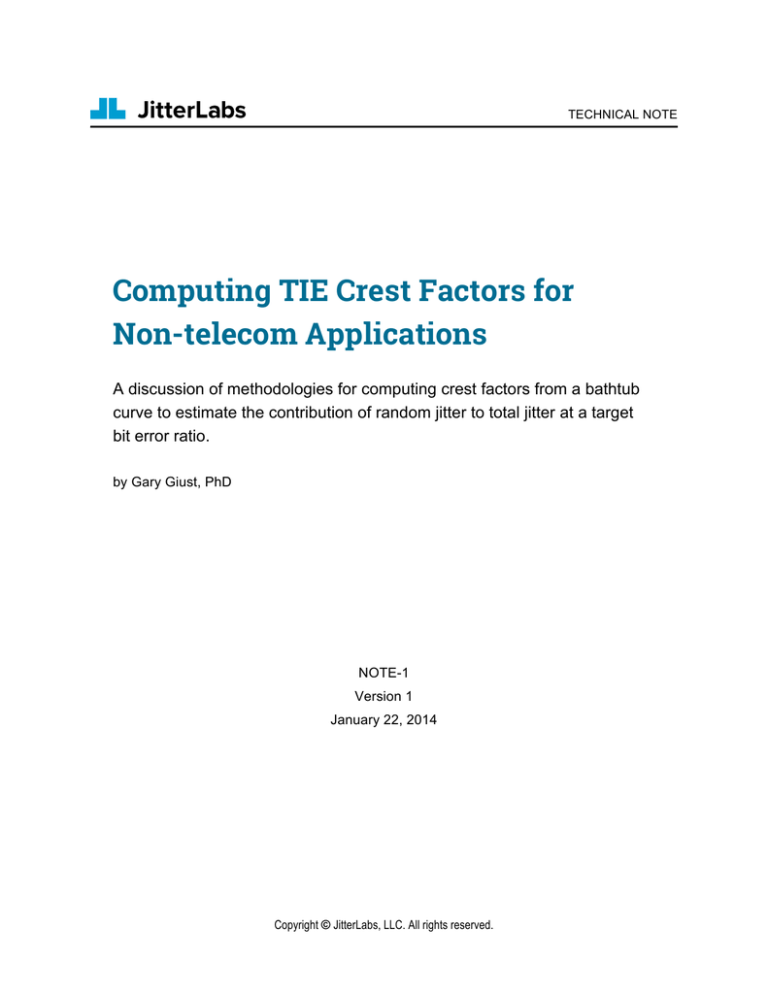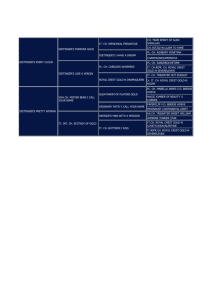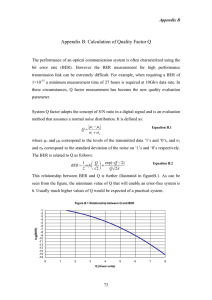
TECHNICAL NOTE
Computing TIE Crest Factors for
Non-telecom Applications
A discussion of methodologies for computing crest factors from a bathtub
curve to estimate the contribution of random jitter to total jitter at a target
bit error ratio.
by Gary Giust, PhD
NOTE-1
Version 1
January 22, 2014
Copyright © JitterLabs, LLC. All rights reserved.
JitterLabs
Table of Contents
Table of Contents
Table of Contents ............................................................................................................................ 2
1 Introduction ............................................................................................................................... 2
2 Computing Crest Factors from a Bathtub Curve ................................................................... 4
3 Computing Crest Factors when DJ Splits the Distribution ................................................... 8
4 Crest Factor Tables ................................................................................................................. 10
5 Conclusion............................................................................................................................... 11
6 References ............................................................................................................................... 11
7 Revision History ...................................................................................................................... 12
1 Introduction
Time-interval error (TIE) is defined as the short-term variations of the significant instants of a
digital signal from their ideal positions in time [1-2]. The methodologies discussed below to
compute crest factors for TIE fall into two groups: methodologies for (1) telecommunications (i.e.
“telecom”) applications, and (2) non-telecom applications. Telecom applications generally
revolve around a narrow group of industry standards including SONET, SDH, and OTN. These
standards quantify total jitter as RMS and peak-peak values based on analog measurements
taken within a 60-second time interval. Non-telecom applications (are assumed here to) include
everything else, and are associated with a wide variety of industry standards (e.g. Fibrechannel, PCI Express, Ethernet, etc.). These standards decompose total jitter into random and
deterministic components to estimate total jitter at a low target bit-error ratio (BER). This
document addresses non-telecom applications. Refer to NOTE-2 [3] for a discussion of telecom
applications.
Any measurement of jitter results in a total jitter (TJ) value. This TJ value may be
decomposed into both random and deterministic components of jitter. The industry refers to the
random component of TJ as random jitter (RJ), and the deterministic component of TJ as
deterministic jitter (DJ).
The TIE crest factor discussed in this document relates only to RJ. Major sources of RJ in a
system include oscillator noise and (in optical systems) photodetector noise. RJ is typically
modeled as a zero-mean Gaussian distribution, also called a normal distribution, as shown in
Figure 1.1, where σ is the standard deviation of the distribution. Note that σ is equivalent to the
RMS value for this distribution since the distribution’s mean is zero.
NOTE-1
page 2 of 12
v1.0
JitterLabs
Introduction
Gaussian distribution, p(x)
1
σ√2ϖ
p(x) =
10-3
X1
1
σ√2ϖ
e
- x2
2σ2
10-6
X2
10-9
10-12
RJ amplitude, x
-6σ
-σ
σ
6σ
Figure 1.1 A Gaussian distribution plotted on a logarithmic scale.
The probability of measuring larger peak-peak RJ values increases with measurement time.
For example, suppose that for given a time T1, a maximum peak-peak RJ value of X1 is
measured. If the measurement time increases to T2, a maximum peak-peak RJ value of X2 may
be measured, where X2≥X1, as shown in Figure 1.1.
The crest factor N is defined (for the purposes of this document) as the ratio of peak-peak to
RMS values, or
N = peak-peak value ÷RMS value
The crest factor may be computed for any signal. For example, the crest factor for a sine wave
is 2 2. The crest factors for X1 and X2 shown in Figure 1.1 are X1÷σ and X2÷σ, respectively.
Regarding RJ for non-telecom applications, the crest factor N specifies how many standard
deviations into the RJ Gaussian tail to include when converting RJ RMS (i.e. σ) to RJ peakpeak. The following sections discuss how to compute the crest factor and use it to estimate the
contribution of RJ to TJ at a target BER using the dual-Dirac model given by,
TJ(target BER) = DJδδ + N(target BER) × σ
where DJδδ is the dual-Dirac deterministic jitter (which consists of a pair of delta functions
separated by a distance of DJδδ) [4].
NOTE-1
page 3 of 12
v1.0
JitterLabs
Computing Crest Factors from a Bathtub Curve
2 Computing Crest Factors from a Bathtub Curve
Figure 2.1 shows an example receiver in a serial-data communications link. The receiver
recovers a bit clock from a data stream and uses it to retime the data at a flip flop. The flip flop’s
decision is analyzed in Figure 2.1 assuming only RJ in the data signal and no jitter in the bit
clock. The RJ in the data signal is drawn (not to scale) as a Gaussian distribution. This
distribution appears at each edge in the data signal, of which two edges (i.e. a right and a left
data edge) are drawn in Figure 2.1.
Data
D
..
.
Channel
RX
PLL
..
.
Retimed
Data
..
.
Q
Bit
Clock
one bit (1 UI)
Data
Bit Clock
RJ distribution
in data signal
left
data
edge
right
data
edge
data is sampled on
rising clock edge
Figure 2.1 Analysis of bit errors due to RJ in an example serial-link receiver.
If the bit clock’s rising edge samples the data, a bit error is seen to occur if (1) the left data
edge arrives late (i.e. to the right of the sampling clock edge), or (2) the right data edge arrives
early (i.e. to the left of the sampling clock edge). The system BER is proportional to the sum of
these two errors. The probability that the data’s left edge arrives late equals the green-shaded
NOTE-1
page 4 of 12
v1.0
JitterLabs
Computing Crest Factors from a Bathtub Curve
region of the left data edge’s distribution divided by the total area of the distribution. The
probability of error from the right data edge is computed similarly using the red-shaded region of
the right data edge’s distribution. Figure 2.1 is arbitrarily drawn with the sampling clock edge
closer to the left data edge than the right data edge. Therefore, the green-shaded region is
larger than the red-shaded region, since more errors are expected from the left data edge than
the right data edge.
Let’s first analyze errors from the left data edge arriving late. The RJ distribution is typically
modeled [4] as a probability density function (PDF) having a zero-mean Gaussian distribution,
or,
𝑝 𝑥 =
!
! !!
𝑒
!!!
!!!
(Equation 1)
where σ is the standard deviation of the distribution. The left data edge’s distribution from Figure
2.1 is redrawn in Figure 2.2, where the sampling clock’s rising edge is located a distance x=Qσ
to the right of the mean location of the left data edge. The shaded area in Figure 2.2 therefore
represents bit errors resulting from the clock sampling the data before the data has settled (i.e.
before the left data edge transitions).
RJ PDF for left data edge, p(x)
RJ amplitude, x
0
Qσ
Figure 2.2 The probability that the left data edge arrives late equals the shaded area divided
by the total area of the distribution.
The probability of a bit error (from the left edge) equals the probability that RJ causes the
data to transition at, or to the right of, the sampling clock transition at x=Qσ, which may be
computed as,
𝐵𝐸𝑅!"#$ 𝑄 = 𝑃 𝑋 ≥ 𝑄𝜎 =
!
𝑝
!"
𝑥 𝑑𝑥
(Equation 2)
Substituting p(x) from Equation 1 gives,
𝐵𝐸𝑅!"#$ 𝑄 =
NOTE-1
!
! !!!
𝑒 !! 𝑑𝑥
! !" !"
!
page 5 of 12
(Equation 3)
v1.0
JitterLabs
Computing Crest Factors from a Bathtub Curve
Performing a change of variable t, where
𝑡=
!
(Equation 4)
!!
simplifies the equation to,
𝐵𝐸𝑅!"#$ 𝑄 =
!
!
!
!
!
!
𝑒 !! 𝑑𝑡
(Equation 5)
which can be rewritten using the complementary error function,
𝑒𝑟𝑓𝑐(𝑧) =
! !! !
𝑒 𝑑𝑡
! !
!
(Equation 6)
as,
𝐵𝐸𝑅!"#$ 𝑄 = 0.5 × 𝑒𝑟𝑓𝑐
!
(Equation 7)
!
where erfc(z) may be computed from a variety of sources including Microsoft Excel.
The discussion so far assumes that the left data edge transition always occurs. Therefore,
Equation 7 is only valid for data signals having a “1010” clock-like data pattern. Since a bit error
can only occur if a data transition exists, the BER should improve (i.e. reduce) for data patterns
having fewer transitions. To account for times when the data does not transition, Equation 7 is
modified as,
𝐵𝐸𝑅!"#$ 𝑄 = 0.5 × 𝐷𝑇𝐷 × 𝑒𝑟𝑓𝑐
!
!
(Equation 8)
where the data-transition density (DTD) is defined as the number of data-edge transitions
divided by the number of data bits. When DTD information is not available, a value of 0.5 is
typically assumed (and accurate for PRBS and 8B/10B encoded data streams).
Equation 8 computes the BER caused by the left data edge arriving late, considering only
RJ, where the RJ has a standard deviation of σ, and where the sampling clock samples the data
at Q standard deviations to the right of the mean location of the left data edge (i.e. the sampling
clock samples the data at Q standard deviations into the tail of the RJ distribution).
Using symmetry, a similar argument can be made to derive BERRight(Q) due to the right data
edge arriving early. A bathtub plot, shown in Figure 2.3, is created by plotting curves for
BERLeft(Q) and BERRight(Q) over one unit interval (UI) (where 1 UI is the duration of one data
bit). The bathtub plot traces out the BER resulting from a sampling clock’s edge stepping
through one bit of data (from the left data edge at 0 UI to the right data edge at 1 UI). From
Figure 2.3, the total eye closure at a target BER is observed as 2Qσ.
NOTE-1
page 6 of 12
v1.0
JitterLabs
Computing Crest Factors from a Bathtub Curve
BER Left
BER Right
0.5 × DTD
1e-3
Eye
Opening
1e-6
target BER
0 UI
1 UI
Qσ
Qσ
Figure 2.3 Bathtub curve created by plotting curves for BERLeft(Q) and BERRight(Q).
In practice, a target BER is known (such as from an industry standard), and the value for σ is
independently measured. Equation 8 is used to solve for Q, and the RJ RMS value (i.e. σ)
converted to peak-peak using,
RJ peak-peak = 2Qσ
By definition, the crest factor N is the ratio of peak-peak to RMS, and equals,
N = RJ peak-peak ÷ σ = 2Q
Substituting N in Equation 8 and solving for a target BER gives,
𝑡𝑎𝑟𝑔𝑒𝑡 𝐵𝐸𝑅 = 0.5 × 𝐷𝑇𝐷 × 𝑒𝑟𝑓𝑐
!
!
(Equation 9)
Table 3.1 summarizes crest factors computed from Equation 9 for a range of target BER and
two common DTD values. This table is typically used to compute the contribution of RJ to TJ at
a given BER.
For example, suppose the data signal shown in Figure 2.1 is a PRBS pattern (i.e. DTD=0.5)
where each data edge has a TIE RJ RMS value of σ. If the application is, for example, 10Gb
Ethernet, then the target BER is 1e-12. The crest factor N may be obtained from the above table
(or Equation 9) to be 13.874, and multiplied by σ to obtain the total peak-peak eye closure (at
the target BER) caused by RJ.
One caveat in the above analysis is an assumption that the amplitude of jitter in the signal is
sufficiently small such that BERLeft >> BERRight where the target BER intersects the BERLeft
curve (and likewise, BERRight >> BERLeft where the target BER intersects the BERRight curve).
This is generally a good assumption (and is built into many standards).
NOTE-1
page 7 of 12
v1.0
JitterLabs
Computing Crest Factors when DJ Splits the Distribution
3 Computing Crest Factors when DJ Splits the Distribution
Some industry standards adopt a methodology advanced by the INCITS Fibre Channel T11
committee, author of the popular MJSQ [5] document, which assumes the dual-Dirac model
splits the RJ distribution into two independent halves. This requires the DJ component to be
large enough that the left side of the distribution has no effect on the right side of the distribution
(and vice versa). Figure 3.1 illustrates this process, where the blue curves (drawn for reference)
correspond to the original RJ distribution discussed in the last section. An example is shown
where this RJ distribution is convolved with a DJ distribution (e.g. modeled using dual-Dirac) to
create a total jitter PDF (top graph) and corresponding BERLeft (bottom graph) curves in red.
The red PDF curve (top graph) illustrates the splitting of the original blue PDF into two halves,
whose effects may be treated independently from the point of view of computing BERLeft.
RJ
RJ
0
DJ
0
-2σ
0
2σ
Left Data Edge PDF, p(x)
0
10
−2
10
A
half of the
...and half to
population
the right
moves to
the left...
−4
10
−6
10
−6
−4
−2
0
2
4
6
x
0
10
RJ RMS, σ = 1
DJ peak = 2σ
DJ Splits the
Distribution
−1
10
Data Transition Density = 0.5
BERLeft(x)
−2
10
2 × target BER
−3
10
target BER
−4
10
−5
10
−6
10
0
Qafter
Qbefore
Qafter
DJ peak
1
2
3
4
5
6
7
x
Figure 3.1 Plots of PDF(x) (top graph) and BERLeft(x) (bottom graph) for a RJ distribution
(blue curves) and a distribution resulting from the convolution of RJ and DJ that splits the
original distribution into two halves in which only the near one effects the error rate (red
curves). The mean location of the left data edge is at x=0 in the above plots.
NOTE-1
page 8 of 12
v1.0
JitterLabs
Computing Crest Factors when DJ Splits the Distribution
The blue BERLeft curve (for the original RJ distribution) may be computed using Equation 8,
where Q is varied from 0 to 7. The Qbefore value shown in Figure 3.1 is obtained by setting
Equation 8 to the target BER (e.g. 1e-3 here) and solving for Q.
After the distribution splits, the dual-Dirac model is still desired to estimate TJ at a low target
BER. Figure 3.1 shows DJδδ is a peak-peak value equal to 2×(DJ peak) = 4σ, and the crest
factor N is evaluated at a target BER of 2×Qafter. The question becomes, how to compute N?
Note that the RJ RMS value of σ does not change when the distribution splits.
Rather than computing the red BERLeft curve then measuring Qafter, it’s simpler to use the
equations developed in the previous section with a little understanding. Analyzing the RJ PDF
after it splits (ignoring DJ temporarily here) is equivalent to analyzing a new PDF that is exactly
half of the original Gaussian distribution discussed in the last section (e.g. half of the blue PDF
in Figure 3.1). In other words, when the PDF splits, half of the population in the original
Gaussian distribution (e.g. blue PDF curve) at point A in Figure 3.1 moves to the right (landing
on the right dual-Dirac half) and half moves to the left (landing on the left dual-Dirac half). It may
be difficult to view, but the peak PDF height drops a factor of two in Figure 3.1 comparing before
(blue) versus after (red) the split.
For the purposes of computing a crest factor, the effect of splitting the original Gaussian
distribution to produce the red BERLeft curve is equivalent to sliding up the (original) blue BERLeft
curve to twice the target BER and solving for Qafter using Equation 8 (or, equivalently, N using
Equation 9), as illustrated in Figure 3.1. Thus, Equation 9 is rewritten, where DJ is sufficiently
large to split a Gaussian distribution, as,
2 × 𝐵𝐸𝑅!"#$ 𝑄 = 𝐷𝑇𝐷 × 𝑒𝑟𝑓𝑐
!
2 × 𝑡𝑎𝑟𝑔𝑒𝑡 𝐵𝐸𝑅 = 𝐷𝑇𝐷 × 𝑒𝑟𝑓𝑐
!
!
!
(Equation 10)
(Equation 11)
Table 3.2 summarizes crest factors computed from Equation 11 for a range of target BER and
two common DTD values.
NOTE-1
page 9 of 12
v1.0
JitterLabs
Crest Factor Tables
4 Crest Factor Tables
Table 3.1 and Table 3.2 below summarize crest factors when the data’s jitter distribution
does not split and does split, respectively, into two independent halves, as discussed in the
previous two sections.
Table 3.1 Equation 9 Crest Factors
(the distribution does not split).
target
NOTE-1
Table 3.2 Equation 11 Crest Factors
(the distribution splits).
Crest Factor (N=2Q)
target Crest Factor (N=2Q)
BER
DTD=0.5
DTD=1
BER
DTD=0.5
DTD=1
1e-1
1.683
2.563
1e-1
0.507
1.683
1e-2
4.108
4.653
1e-2
3.501
4.108
1e-3
5.756
6.180
1e-3
5.304
5.756
1e-4
7.080
7.438
1e-4
6.706
7.080
1e-5
8.215
8.530
1e-5
7.889
8.215
1e-6
9.223
9.507
1e-6
8.930
9.223
1e-7
10.138
10.399
1e-7
9.871
10.138
1e-8
10.982
11.224
1e-8
10.734
10.982
1e-9
11.768
11.996
1e-9
11.537
11.768
1e-10
12.508
12.723
1e-10
12.290
12.508
1e-11
13.208
13.412
1e-11
13.001
13.208
1e-12
13.874
14.069
1e-12
13.677
13.874
1e-13
14.511
14.698
1e-13
14.322
14.511
1e-14
15.122
15.301
1e-14
14.941
15.122
1e-15
15.710
15.883
1e-15
15.535
15.710
1e-16
16.277
16.444
1e-16
16.108
16.277
page 10 of 12
v1.0
JitterLabs
Conclusion
5 Conclusion
This note presented two common methods for computing TIE crest factors. Equation 10
(Table 3.2) should be used when only one half of the dual-Dirac distribution contributes to errors
in the bathtub curve (at the location where the target BER is evaluated). Otherwise, if both
halves contribute to errors, for example (1) if there is no DJ, or (2) if there is a lot of jitter
(random, deterministic, or both) centered at the mean location of the data edge, then Equation 9
(Table 3.2) is more accurate. When in doubt, assuming the distribution does not split (Equation
9) provides a more pessimistic result. At a target BER of 1e-12, the difference is less than 2%.
Finally, keep in mind that it is the data signal’s jitter distribution (see Figure 2.1) that must be
evaluated to determine which method to compute the crest factor. Of course, clock jitter can still
play an important role. For example, suppose one wishes to estimate how much a clock device
contributes to an application’s TJ budget for data, where the clock is used to retime the data.
Here, one may multiply the clock device’s phase jitter RMS value (e.g. TIE RJ RMS value) by a
crest factor obtained from Equation 11 (Table 3.2), even if the clock device only has random
jitter, if the customer’s application is known (or defined by an industry standard) to have
sufficient DJ such that the data’s jitter distribution (after being timed by the clock) splits as
described above.
6 References
[1] “Understanding and Characterizing Timing Jitter,” application note, Tektronix (2003).
[2] “Synchronous Optical Network (SONET) Transport Systems: Common Generic Criteria,”
Telcordia, GR-253-CORE, Issue 4 (December 2005), section 2.2.4.
[3] NOTE-2, “Computing TIE Crest Factors for Telecom Applications,” JitterLabs,
https://www.jitterlabs.com
[4] “Jitter Analysis: The dual-Dirac Model, RJ/DJ, and Q-Scale,” White Paper by Ransom
Stephens, Agilent Technologies (December 31, 2004),
http://cp.literature.agilent.com/litweb/pdf/5989-3206EN.pdf
[5] “Methodologies for Jitter and Signal Quality Specification (MJSQ),” INCITS, Fibre
Channel, T11.2 / Project 1316-DT/ Rev 14.1 (June 2005).
NOTE-1
page 11 of 12
v1.0
JitterLabs
Revision History
7 Revision History
Table 7.1 Revision History
Version
1.0
NOTE-1
Date
Changes
January 22, 2014
Initial release.
page 12 of 12
v1.0





